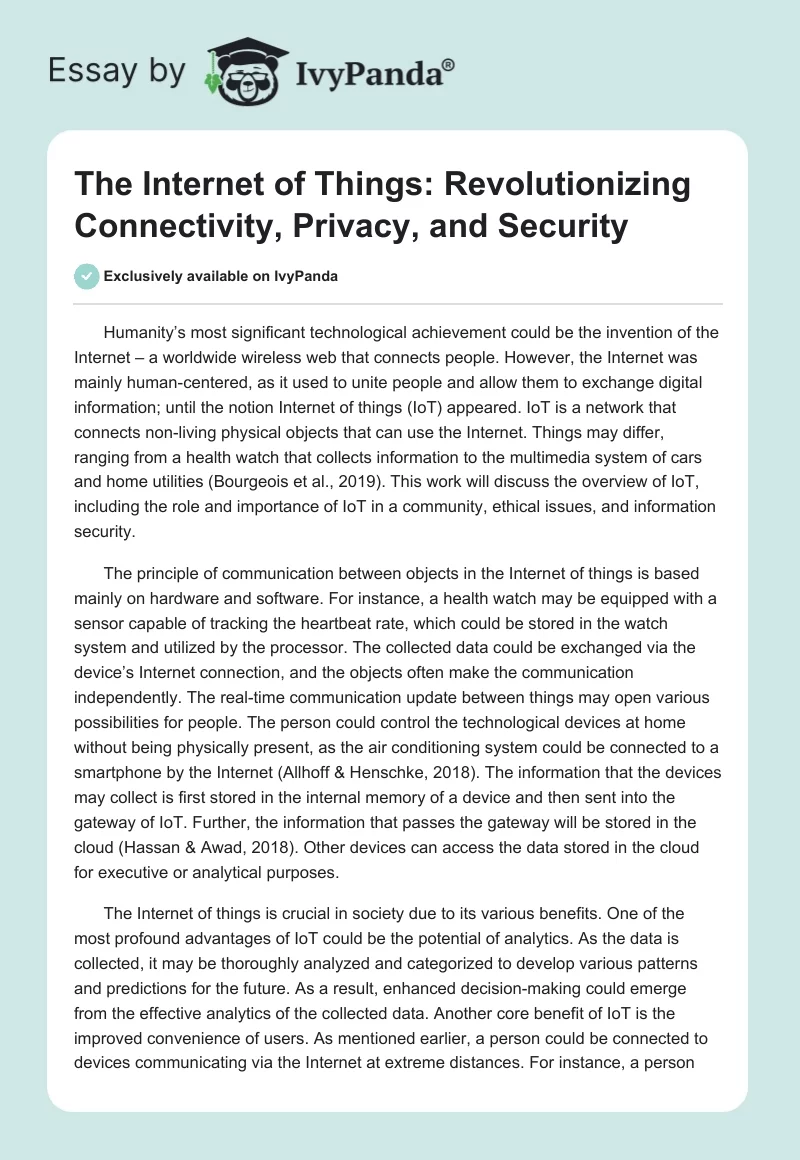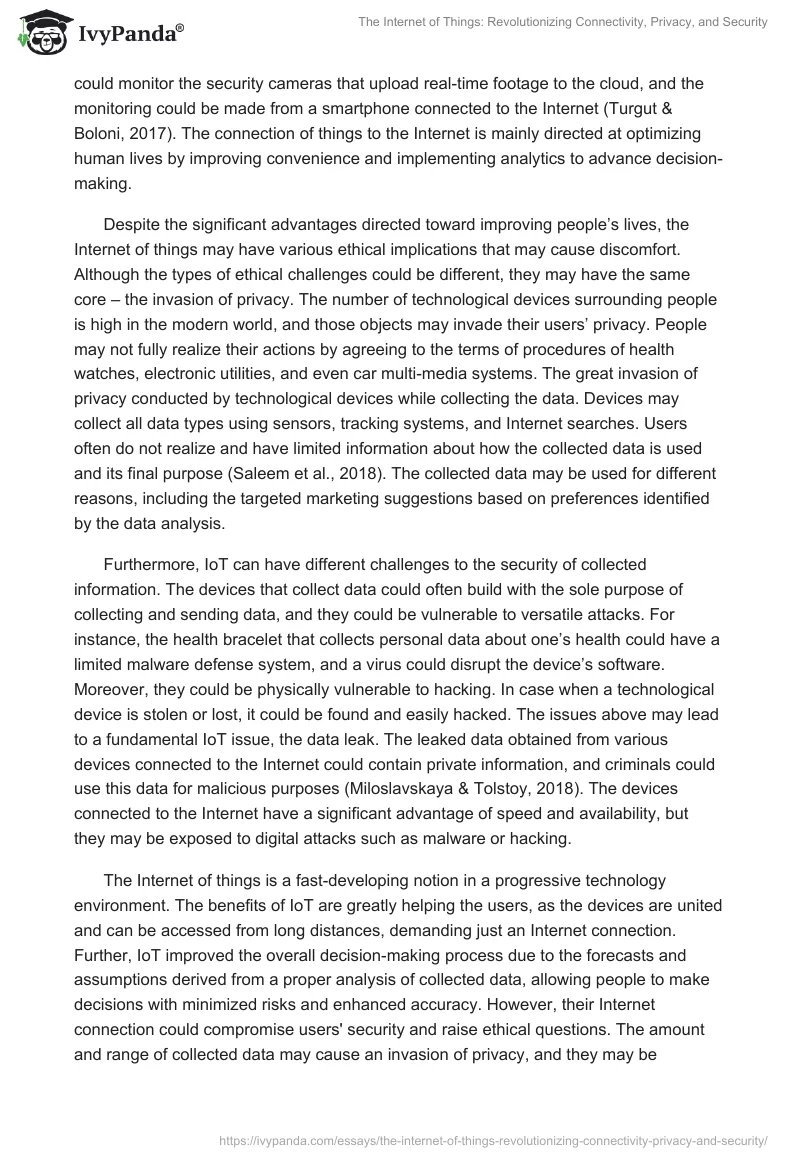Humanity’s most significant technological achievement could be the invention of the Internet – a worldwide wireless web that connects people. However, the Internet was mainly human-centered, as it used to unite people and allow them to exchange digital information; until the notion Internet of things (IoT) appeared. IoT is a network that connects non-living physical objects that can use the Internet. Things may differ, ranging from a health watch that collects information to the multimedia system of cars and home utilities (Bourgeois et al., 2019). This work will discuss the overview of IoT, including the role and importance of IoT in a community, ethical issues, and information security.
The principle of communication between objects in the Internet of things is based mainly on hardware and software. For instance, a health watch may be equipped with a sensor capable of tracking the heartbeat rate, which could be stored in the watch system and utilized by the processor. The collected data could be exchanged via the device’s Internet connection, and the objects often make the communication independently. The real-time communication update between things may open various possibilities for people. The person could control the technological devices at home without being physically present, as the air conditioning system could be connected to a smartphone by the Internet (Allhoff & Henschke, 2018). The information that the devices may collect is first stored in the internal memory of a device and then sent into the gateway of IoT. Further, the information that passes the gateway will be stored in the cloud (Hassan & Awad, 2018). Other devices can access the data stored in the cloud for executive or analytical purposes.
The Internet of things is crucial in society due to its various benefits. One of the most profound advantages of IoT could be the potential of analytics. As the data is collected, it may be thoroughly analyzed and categorized to develop various patterns and predictions for the future. As a result, enhanced decision-making could emerge from the effective analytics of the collected data. Another core benefit of IoT is the improved convenience of users. As mentioned earlier, a person could be connected to devices communicating via the Internet at extreme distances. For instance, a person could monitor the security cameras that upload real-time footage to the cloud, and the monitoring could be made from a smartphone connected to the Internet (Turgut & Boloni, 2017). The connection of things to the Internet is mainly directed at optimizing human lives by improving convenience and implementing analytics to advance decision-making.
Despite the significant advantages directed toward improving people’s lives, the Internet of things may have various ethical implications that may cause discomfort. Although the types of ethical challenges could be different, they may have the same core – the invasion of privacy. The number of technological devices surrounding people is high in the modern world, and those objects may invade their users’ privacy. People may not fully realize their actions by agreeing to the terms of procedures of health watches, electronic utilities, and even car multi-media systems. The great invasion of privacy conducted by technological devices while collecting the data. Devices may collect all data types using sensors, tracking systems, and Internet searches. Users often do not realize and have limited information about how the collected data is used and its final purpose (Saleem et al., 2018). The collected data may be used for different reasons, including the targeted marketing suggestions based on preferences identified by the data analysis.
Furthermore, IoT can have different challenges to the security of collected information. The devices that collect data could often build with the sole purpose of collecting and sending data, and they could be vulnerable to versatile attacks. For instance, the health bracelet that collects personal data about one’s health could have a limited malware defense system, and a virus could disrupt the device’s software. Moreover, they could be physically vulnerable to hacking. In case when a technological device is stolen or lost, it could be found and easily hacked. The issues above may lead to a fundamental IoT issue, the data leak. The leaked data obtained from various devices connected to the Internet could contain private information, and criminals could use this data for malicious purposes (Miloslavskaya & Tolstoy, 2018). The devices connected to the Internet have a significant advantage of speed and availability, but they may be exposed to digital attacks such as malware or hacking.
The Internet of things is a fast-developing notion in a progressive technology environment. The benefits of IoT are greatly helping the users, as the devices are united and can be accessed from long distances, demanding just an Internet connection. Further, IoT improved the overall decision-making process due to the forecasts and assumptions derived from a proper analysis of collected data, allowing people to make decisions with minimized risks and enhanced accuracy. However, their Internet connection could compromise users’ security and raise ethical questions. The amount and range of collected data may cause an invasion of privacy, and they may be vulnerable to digital threats. IoT’s improved security could improve people’s trust in devices, as they may not be afraid of data leaks and software corruption.
References
Allhoff, F., & Henschke, A. (2018). The Internet of Things: Foundational ethical issues.Internet Of Things, 1(2), 55-66. Web.
Bourgeois, D., Smith, J., Wang, S., & Mortati, J. (2019). Information Systems for Business and Beyond. Saylor Foundation.
Hassan, A., & Awad, A. (2018). Urban transition in the era of the Internet of things: Social implications and privacy challenges.IEEE Access, 6, 36428-36440. Web.
Miloslavskaya, N., & Tolstoy, A. (2018). Internet of Things: information security challenges and solutions.Cluster Computing, 22(1), 103-119. Web.
Turgut, D., & Boloni, L. (2017). Value of information and cost of privacy in the Internet of things.IEEE Communications Magazine, 55(9), 62-66. Web.
Saleem, J., Hammoudeh, M., Raza, U., Adebisi, B., & Ande, R. (2018). IoT standardisation – challenges, perspectives and solution.Proceedings Of The 2Nd International Conference On Future Networks And Distributed Systems, 18. Web.


